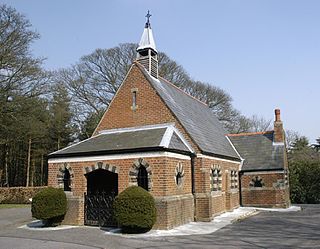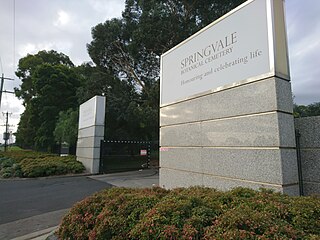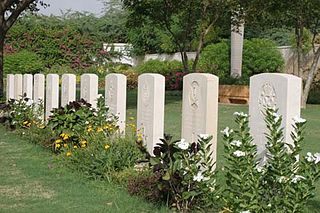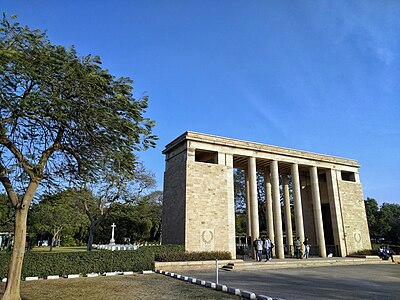
El Alamein is a town in the northern Matrouh Governorate of Egypt. Located on the Arab's Gulf, Mediterranean Sea, it lies 106 kilometres (66 mi) west of Alexandria and 300 kilometres (186 mi) northwest of Cairo. As of 2007, it had a population of 7,397 inhabitants.

The Commonwealth War Graves Commission (CWGC) is an intergovernmental organisation of six independent member states whose principal function is to mark, record and maintain the graves and places of commemoration of Commonwealth of Nations military service members who died in the two World Wars. The commission is also responsible for commemorating Commonwealth civilians who died as a result of enemy action during the Second World War. The commission was founded by Sir Fabian Ware and constituted through Royal Charter in 1917 as the Imperial War Graves Commission. The change to the present name took place in 1960.

Brookwood Cemetery, also known as the London Necropolis, is a burial ground in Brookwood, Surrey, England. It is the largest cemetery in the United Kingdom and one of the largest in Europe. The cemetery is listed a Grade I site in the Register of Historic Parks and Gardens.

Rookwood Cemetery is a heritage-listed cemetery in Rookwood, Sydney, New South Wales, Australia. It is the largest necropolis in the Southern Hemisphere and is the world's largest remaining operating cemetery from the Victorian era. It is close to Lidcombe railway station about 17 kilometres (11 mi) west of the Sydney central business district. It was added to the New South Wales State Heritage Register on 2 April 1999.

Sai Wan War Cemetery is a military cemetery located in Chai Wan, Hong Kong which was built in 1946. The cemetery was created to commemorate soldiers of Hong Kong Garrison who perished during the Second World War. The cemetery also contains 12 World War I burials. A total of 1,528 soldiers, mainly from the Commonwealth, are commemorated here. Most of the remaining burials are located at the Stanley Military Cemetery.
Khadki is a cantonment in the city of Pune, India. It has now flourished as a quasi-metropolis & centered in the northern region of the city.

Aldershot Military Cemetery is a burial ground for military personnel, or ex-military personnel and their families, located in Aldershot Military Town, Hampshire.

The Springvale Botanical Cemetery is the largest crematorium and memorial park in Victoria, Australia. It is located in Springvale, in the south-eastern suburbs of Melbourne.

The Berlin 1939–1945 War Cemetery is one of two Commonwealth War Graves Commission (CWGC) cemeteries in Berlin, the other being the World War I Berlin South-Western Cemetery in Stahnsdorf, Brandenburg. The Berlin 1939–1945 War Cemetery was established in 1945 as a central burial ground for aircrew and prisoners of war who were interred in the Berlin area and in East Germany. There are also 260 burials from the post-war British Occupation Authorities staff, or their relatives. Of the wartime burials, about 80% are aircrew, killed in action over Germany: the remainder are prisoners of war.

The Karachi War Cemetery was created to receive World War II dead from cemeteries scattered across the country, as it was felt that their proper maintenance could not be assured.

Madras War Cemetery is located in Nandambakkam, Chennai, Tamil Nadu, India. It was created to receive Second World War graves from civil and cantonment cemeteries in the south and east of India where their permanent maintenance could not be assured.

Beechwood Cemetery is the national cemetery of Canada, located in Vanier, Ottawa, Ontario. A woodland cemetery founded in 1873, it is 64.7 hectares and is the largest cemetery in the city of Ottawa. Over 82,000 Canadians from all walks of life are buried in the cemetery, including Governor General Ramon Hnatyshyn, Prime Minister Robert Borden, and several members of Parliament, premiers, Canadian Armed Forces personnel and veterans, Royal Canadian Mounted Police personnel, Canadian Security Intelligence Service intelligence officers, and Hockey Hall of Famers, alongside other notable Canadians. In addition to being Canada's national cemetery, it is also the national military cemetery of Canada and the national memorial cemetery of the RCMP.

The Arras Flying Services Memorial Commonwealth War Graves Commission war memorial in the Faubourg d'Amiens Cemetery, Arras, France. The memorial commemorates nearly 1,000 airmen from forces of the Commonwealth who were killed on the Western Front during World War I and who have no known grave. The memorial was designed by Edwin Lutyens, sculpted by William Reid Dick and unveiled by Hugh Trenchard, 1st Viscount Trenchard, Marshal of the Royal Air Force on 31 July 1932.

The North Front Cemetery is a cemetery located in the British Overseas Territory of Gibraltar. Also known as the Gibraltar Cemetery and the Garrison Cemetery, it is the only graveyard still in use in Gibraltar. It is also the only Commonwealth War Graves Commission (CWGC) cemetery in Gibraltar. The two CWGC monuments, the Gibraltar Memorial and the Gibraltar Cross of Sacrifice, are positioned nearby at the junction of Winston Churchill Avenue and Devil's Tower Road.

The Gibraltar Cross of Sacrifice is a war memorial in the British Overseas Territory of Gibraltar. It is located west of North Front Cemetery, at the junction of Winston Churchill Avenue and Devil's Tower Road. The Cross of Sacrifice was designed by Sir Reginald Blomfield in 1917, and his monument is found in numerous Commonwealth War Graves Commission cemeteries. The cross in Gibraltar was erected by the Royal Engineers for the commission, and unveiled on Armistice Day 1922. The British Pathé film recorded at the dedication ceremony that day represents the first motion picture made in Gibraltar. The Gibraltar Cross of Sacrifice served as the focus of Remembrance Sunday ceremonies in Gibraltar until 2009, at which time the location was changed to the Gibraltar War Memorial.

Yokohama War Cemetery is a military cemetery in Hodogaya-ku, Yokohama, in Japan and located next to Yokohama Municipal Children's Botanical Garden.

Cambridge City Cemetery is the main burial ground for the city of Cambridge in Cambridgeshire. It is to the north of the city, at the junction of Newmarket Road and Ditton Lane, near to Cambridge Airport.
Philip Dalton Hepworth was a British architect. He studied in both the UK and France, at the Architectural Association School of Architecture and the École des Beaux-Arts, and returned to work as an architect after serving in the First World War. He rose to prominence in the 1930s, featuring in a book by architectural critic Trystan Edwards and winning the commission in 1932 to design Walthamstow Town Hall, which was eventually completed in 1942. Another civic building of this period was Wiltshire County Hall at Trowbridge. He also designed a handful of private houses, including Pemberley, in Loughton, 1936. He lived in Zoffany House in Strand-on-the-Green, Chiswick, London, from 1936.

The Kirkee War Cemetery is a cemetery in Khadki, a cantonment in Pune in Maharashtra, India. The cemetery was created to provide graves for the fallen from central and western India in the Second World War, where there could not be certainty about their graves elsewhere being permanently maintained.






















